A Comprehensive Film Review: Obit: Life on Deadline Analysis
VerifiedAdded on 2020/05/16
|8
|1300
|57
Report
AI Summary
This film review analyzes the documentary "Obit: Life on Deadline" directed by Vanessa Gould, offering a deep dive into the world of journalism and obituary writing. The review explores the film's depiction of the daily lives of obituary writers, their struggles with deadlines, and the art of crafting compelling obituaries. It examines the cinematography, screenplay, and casting, highlighting the film's artistic perspective and its impact on the audience's perception of journalism. The review discusses the film's portrayal of the writers' emotional experiences, challenges the traditional view of obituary writing, and compares it to the works of Thackeray. It also explores the film's unique perspective on the importance of print journalism, the selection of content and the space allocated to the deceased personalities. The reviewer agrees with the film's depiction of the profession, appreciating its humor, wit, and the insights it provides into the lives of the writers and the value of obituary writing. The review also includes a list of relevant keywords and a bibliography.
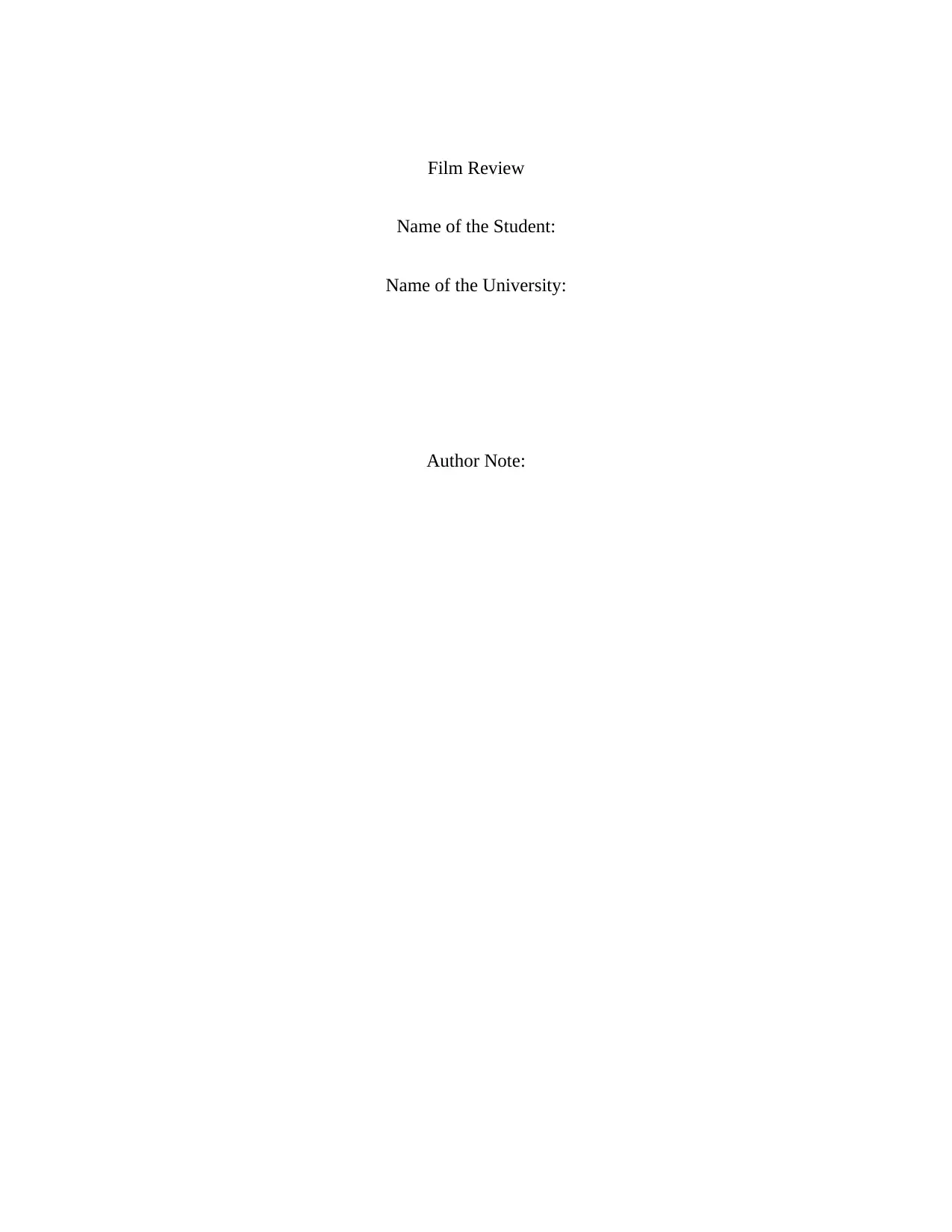
Film Review
Name of the Student:
Name of the University:
Author Note:
Name of the Student:
Name of the University:
Author Note:
Paraphrase This Document
Need a fresh take? Get an instant paraphrase of this document with our AI Paraphraser
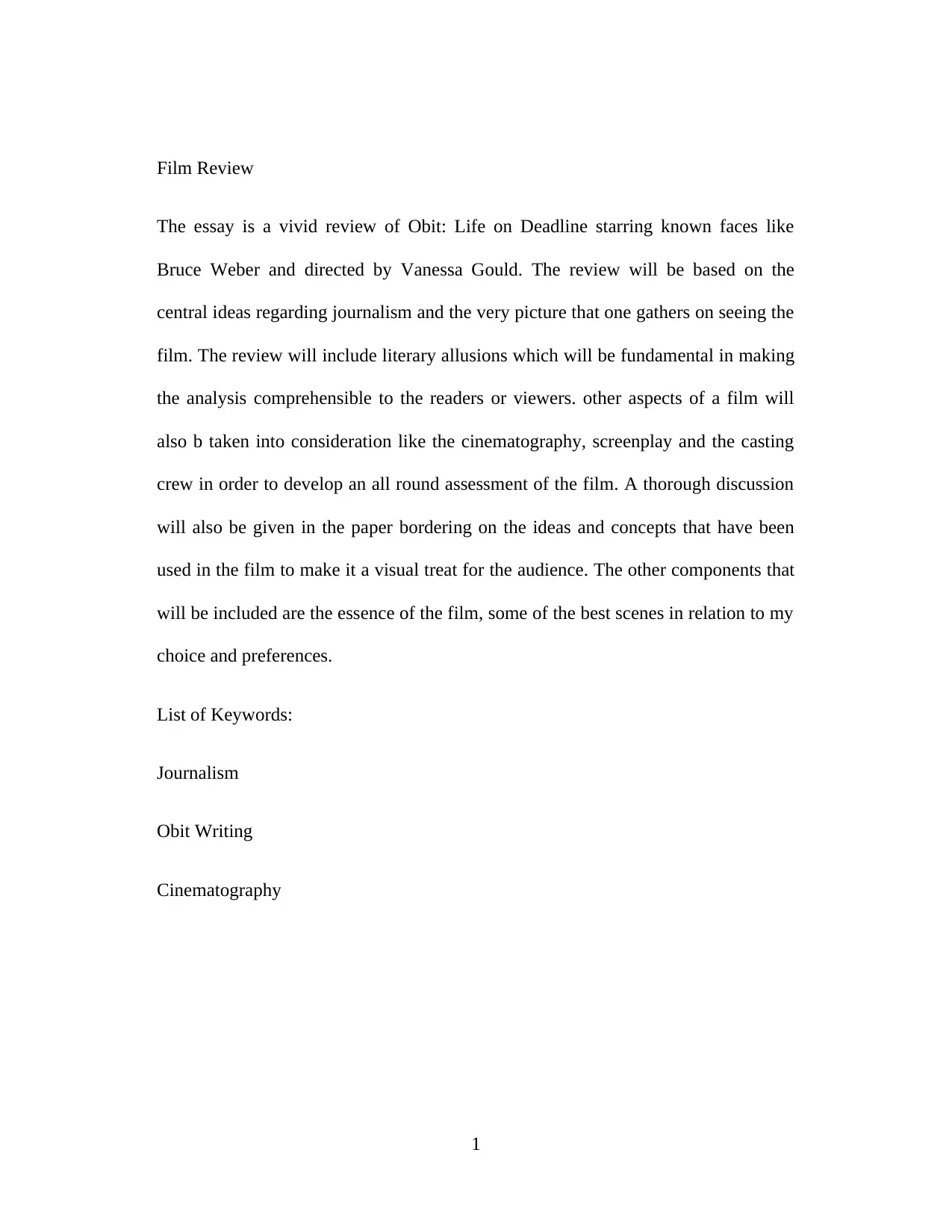
Film Review
The essay is a vivid review of Obit: Life on Deadline starring known faces like
Bruce Weber and directed by Vanessa Gould. The review will be based on the
central ideas regarding journalism and the very picture that one gathers on seeing the
film. The review will include literary allusions which will be fundamental in making
the analysis comprehensible to the readers or viewers. other aspects of a film will
also b taken into consideration like the cinematography, screenplay and the casting
crew in order to develop an all round assessment of the film. A thorough discussion
will also be given in the paper bordering on the ideas and concepts that have been
used in the film to make it a visual treat for the audience. The other components that
will be included are the essence of the film, some of the best scenes in relation to my
choice and preferences.
List of Keywords:
Journalism
Obit Writing
Cinematography
1
The essay is a vivid review of Obit: Life on Deadline starring known faces like
Bruce Weber and directed by Vanessa Gould. The review will be based on the
central ideas regarding journalism and the very picture that one gathers on seeing the
film. The review will include literary allusions which will be fundamental in making
the analysis comprehensible to the readers or viewers. other aspects of a film will
also b taken into consideration like the cinematography, screenplay and the casting
crew in order to develop an all round assessment of the film. A thorough discussion
will also be given in the paper bordering on the ideas and concepts that have been
used in the film to make it a visual treat for the audience. The other components that
will be included are the essence of the film, some of the best scenes in relation to my
choice and preferences.
List of Keywords:
Journalism
Obit Writing
Cinematography
1

Film Review
2
2
⊘ This is a preview!⊘
Do you want full access?
Subscribe today to unlock all pages.

Trusted by 1+ million students worldwide
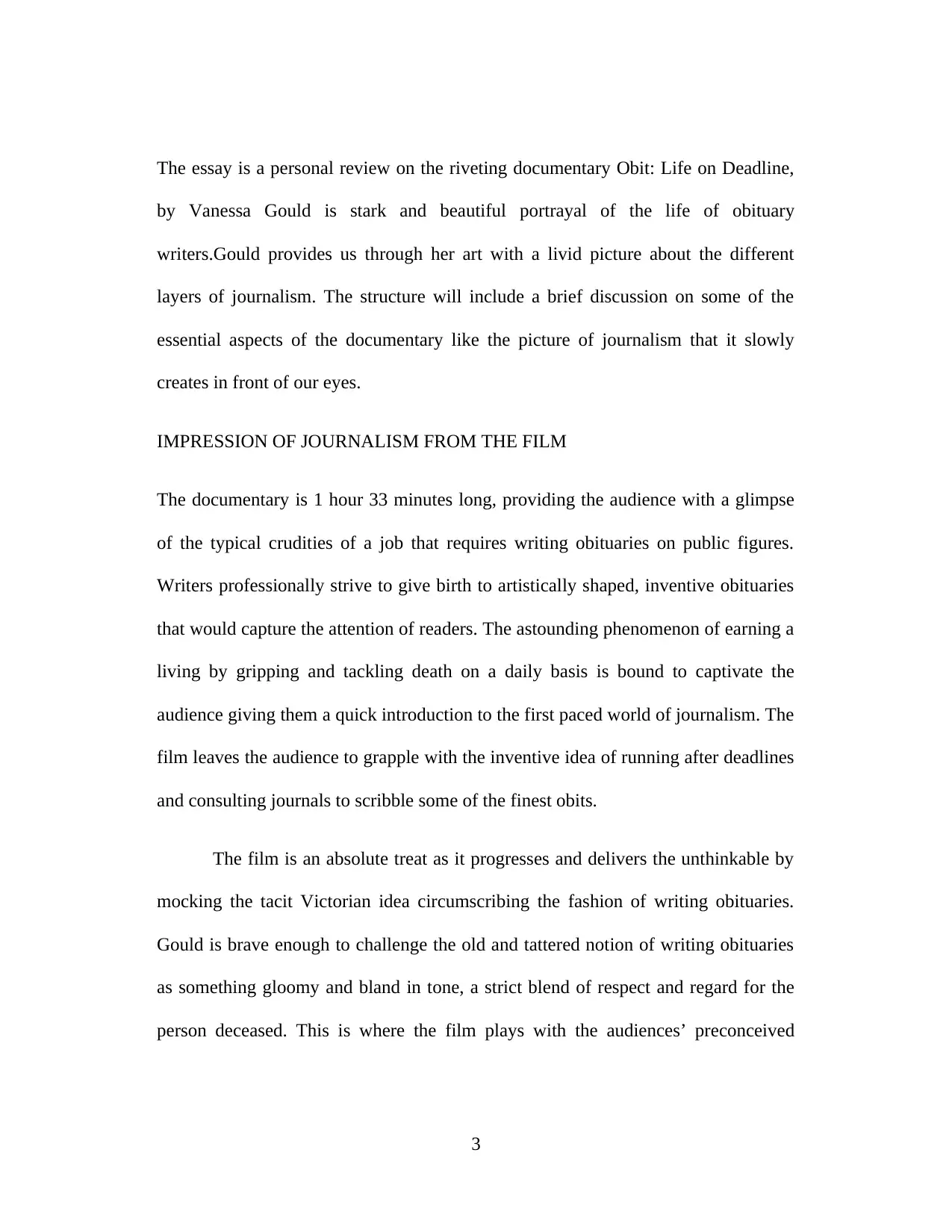
The essay is a personal review on the riveting documentary Obit: Life on Deadline,
by Vanessa Gould is stark and beautiful portrayal of the life of obituary
writers.Gould provides us through her art with a livid picture about the different
layers of journalism. The structure will include a brief discussion on some of the
essential aspects of the documentary like the picture of journalism that it slowly
creates in front of our eyes.
IMPRESSION OF JOURNALISM FROM THE FILM
The documentary is 1 hour 33 minutes long, providing the audience with a glimpse
of the typical crudities of a job that requires writing obituaries on public figures.
Writers professionally strive to give birth to artistically shaped, inventive obituaries
that would capture the attention of readers. The astounding phenomenon of earning a
living by gripping and tackling death on a daily basis is bound to captivate the
audience giving them a quick introduction to the first paced world of journalism. The
film leaves the audience to grapple with the inventive idea of running after deadlines
and consulting journals to scribble some of the finest obits.
The film is an absolute treat as it progresses and delivers the unthinkable by
mocking the tacit Victorian idea circumscribing the fashion of writing obituaries.
Gould is brave enough to challenge the old and tattered notion of writing obituaries
as something gloomy and bland in tone, a strict blend of respect and regard for the
person deceased. This is where the film plays with the audiences’ preconceived
3
by Vanessa Gould is stark and beautiful portrayal of the life of obituary
writers.Gould provides us through her art with a livid picture about the different
layers of journalism. The structure will include a brief discussion on some of the
essential aspects of the documentary like the picture of journalism that it slowly
creates in front of our eyes.
IMPRESSION OF JOURNALISM FROM THE FILM
The documentary is 1 hour 33 minutes long, providing the audience with a glimpse
of the typical crudities of a job that requires writing obituaries on public figures.
Writers professionally strive to give birth to artistically shaped, inventive obituaries
that would capture the attention of readers. The astounding phenomenon of earning a
living by gripping and tackling death on a daily basis is bound to captivate the
audience giving them a quick introduction to the first paced world of journalism. The
film leaves the audience to grapple with the inventive idea of running after deadlines
and consulting journals to scribble some of the finest obits.
The film is an absolute treat as it progresses and delivers the unthinkable by
mocking the tacit Victorian idea circumscribing the fashion of writing obituaries.
Gould is brave enough to challenge the old and tattered notion of writing obituaries
as something gloomy and bland in tone, a strict blend of respect and regard for the
person deceased. This is where the film plays with the audiences’ preconceived
3
Paraphrase This Document
Need a fresh take? Get an instant paraphrase of this document with our AI Paraphraser

notion regarding writing obituaries and to consider a kaleidoscopic view, the world
of journalism.
What I Liked About The Film
What I liked most about the film is the cinematography which centralizes audiences’
attention on the media desk and the charming David Carr, to steal the frame. The art
of making motion picture plays a role in ensuring that the final product is not just a
mere amalgamation of ideas and information. On the very surface, Obit: Life on
Deadlines appears nothing more than a tedious documentary on death which involves
the accumulation of facts and data, arranging them in a synchronized manner is a
matter ofemotional roller-coaster ride for the writers themselves. However, the
director has invested the film with an artist’s perspective, which is nevertheless, not
disparate from the real life. The intrigue lies as the camera zooms into the panic
stricken faces of the writers struggling to come up with engrossing leads to make the
obituary attractive to its readers. This is exactly where the narrative jolts the
audiences as they witness the whole affair with a rather sadistic pleasure of seeing
the writers crumbling under the burden of writing obits.
Do I agree with the film?
I agree with what the film shows and the documentary never had a dull moment as it
gives a colorful view in a collage form, often in an inoffensive and humorous way of
depicting the lives of the writers. Bruce and Margalit Fox have scribbled around
4
of journalism.
What I Liked About The Film
What I liked most about the film is the cinematography which centralizes audiences’
attention on the media desk and the charming David Carr, to steal the frame. The art
of making motion picture plays a role in ensuring that the final product is not just a
mere amalgamation of ideas and information. On the very surface, Obit: Life on
Deadlines appears nothing more than a tedious documentary on death which involves
the accumulation of facts and data, arranging them in a synchronized manner is a
matter ofemotional roller-coaster ride for the writers themselves. However, the
director has invested the film with an artist’s perspective, which is nevertheless, not
disparate from the real life. The intrigue lies as the camera zooms into the panic
stricken faces of the writers struggling to come up with engrossing leads to make the
obituary attractive to its readers. This is exactly where the narrative jolts the
audiences as they witness the whole affair with a rather sadistic pleasure of seeing
the writers crumbling under the burden of writing obits.
Do I agree with the film?
I agree with what the film shows and the documentary never had a dull moment as it
gives a colorful view in a collage form, often in an inoffensive and humorous way of
depicting the lives of the writers. Bruce and Margalit Fox have scribbled around
4
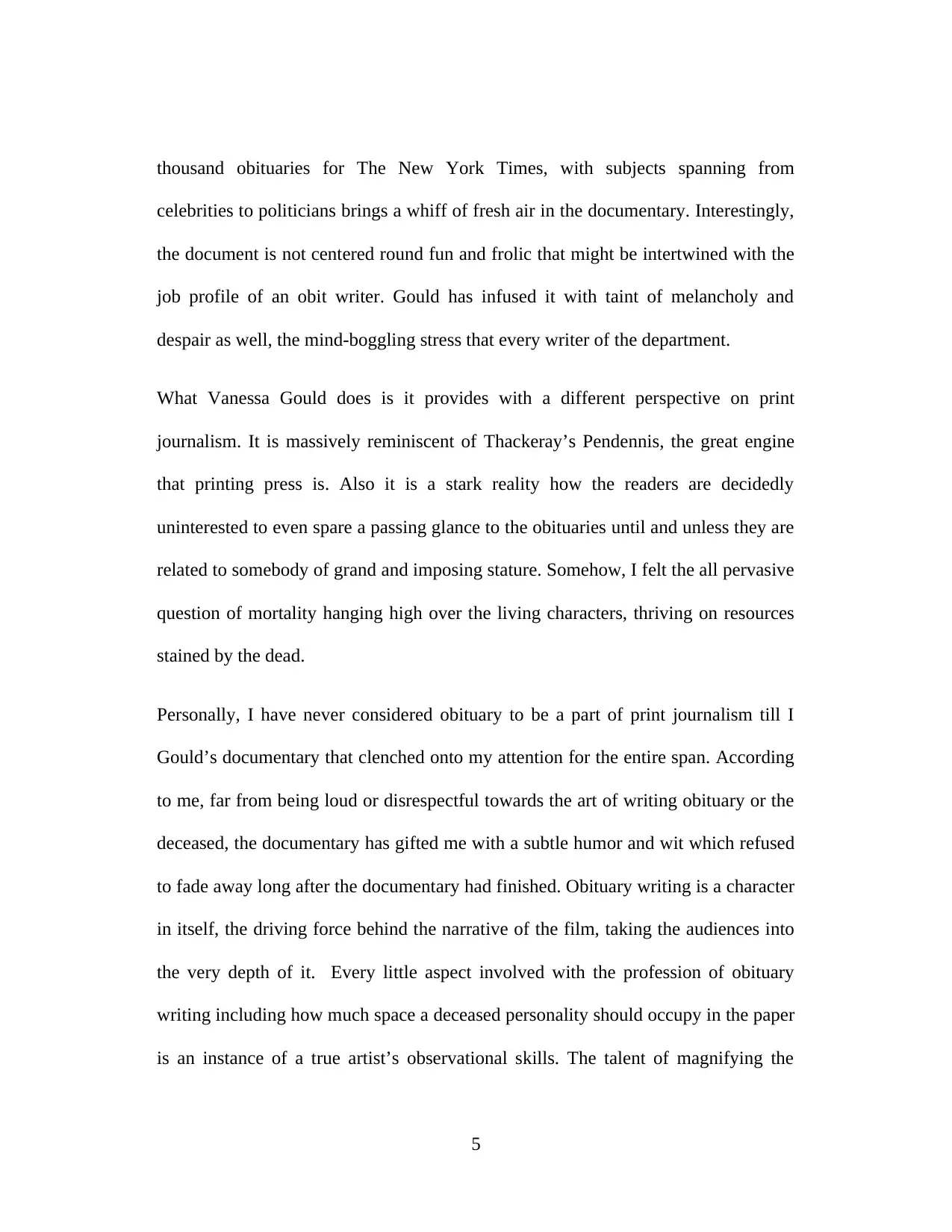
thousand obituaries for The New York Times, with subjects spanning from
celebrities to politicians brings a whiff of fresh air in the documentary. Interestingly,
the document is not centered round fun and frolic that might be intertwined with the
job profile of an obit writer. Gould has infused it with taint of melancholy and
despair as well, the mind-boggling stress that every writer of the department.
What Vanessa Gould does is it provides with a different perspective on print
journalism. It is massively reminiscent of Thackeray’s Pendennis, the great engine
that printing press is. Also it is a stark reality how the readers are decidedly
uninterested to even spare a passing glance to the obituaries until and unless they are
related to somebody of grand and imposing stature. Somehow, I felt the all pervasive
question of mortality hanging high over the living characters, thriving on resources
stained by the dead.
Personally, I have never considered obituary to be a part of print journalism till I
Gould’s documentary that clenched onto my attention for the entire span. According
to me, far from being loud or disrespectful towards the art of writing obituary or the
deceased, the documentary has gifted me with a subtle humor and wit which refused
to fade away long after the documentary had finished. Obituary writing is a character
in itself, the driving force behind the narrative of the film, taking the audiences into
the very depth of it. Every little aspect involved with the profession of obituary
writing including how much space a deceased personality should occupy in the paper
is an instance of a true artist’s observational skills. The talent of magnifying the
5
celebrities to politicians brings a whiff of fresh air in the documentary. Interestingly,
the document is not centered round fun and frolic that might be intertwined with the
job profile of an obit writer. Gould has infused it with taint of melancholy and
despair as well, the mind-boggling stress that every writer of the department.
What Vanessa Gould does is it provides with a different perspective on print
journalism. It is massively reminiscent of Thackeray’s Pendennis, the great engine
that printing press is. Also it is a stark reality how the readers are decidedly
uninterested to even spare a passing glance to the obituaries until and unless they are
related to somebody of grand and imposing stature. Somehow, I felt the all pervasive
question of mortality hanging high over the living characters, thriving on resources
stained by the dead.
Personally, I have never considered obituary to be a part of print journalism till I
Gould’s documentary that clenched onto my attention for the entire span. According
to me, far from being loud or disrespectful towards the art of writing obituary or the
deceased, the documentary has gifted me with a subtle humor and wit which refused
to fade away long after the documentary had finished. Obituary writing is a character
in itself, the driving force behind the narrative of the film, taking the audiences into
the very depth of it. Every little aspect involved with the profession of obituary
writing including how much space a deceased personality should occupy in the paper
is an instance of a true artist’s observational skills. The talent of magnifying the
5
⊘ This is a preview!⊘
Do you want full access?
Subscribe today to unlock all pages.

Trusted by 1+ million students worldwide
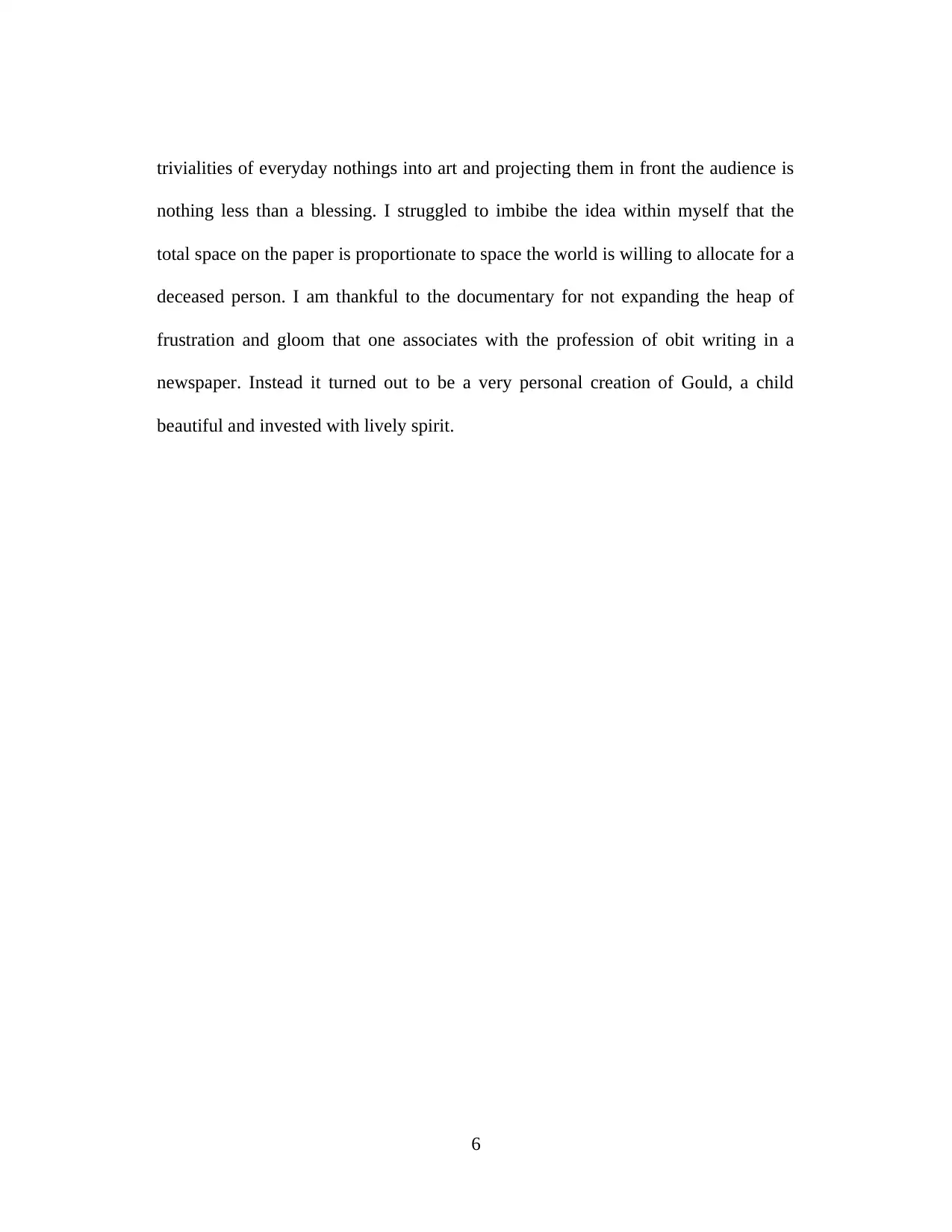
trivialities of everyday nothings into art and projecting them in front the audience is
nothing less than a blessing. I struggled to imbibe the idea within myself that the
total space on the paper is proportionate to space the world is willing to allocate for a
deceased person. I am thankful to the documentary for not expanding the heap of
frustration and gloom that one associates with the profession of obit writing in a
newspaper. Instead it turned out to be a very personal creation of Gould, a child
beautiful and invested with lively spirit.
6
nothing less than a blessing. I struggled to imbibe the idea within myself that the
total space on the paper is proportionate to space the world is willing to allocate for a
deceased person. I am thankful to the documentary for not expanding the heap of
frustration and gloom that one associates with the profession of obit writing in a
newspaper. Instead it turned out to be a very personal creation of Gould, a child
beautiful and invested with lively spirit.
6
Paraphrase This Document
Need a fresh take? Get an instant paraphrase of this document with our AI Paraphraser
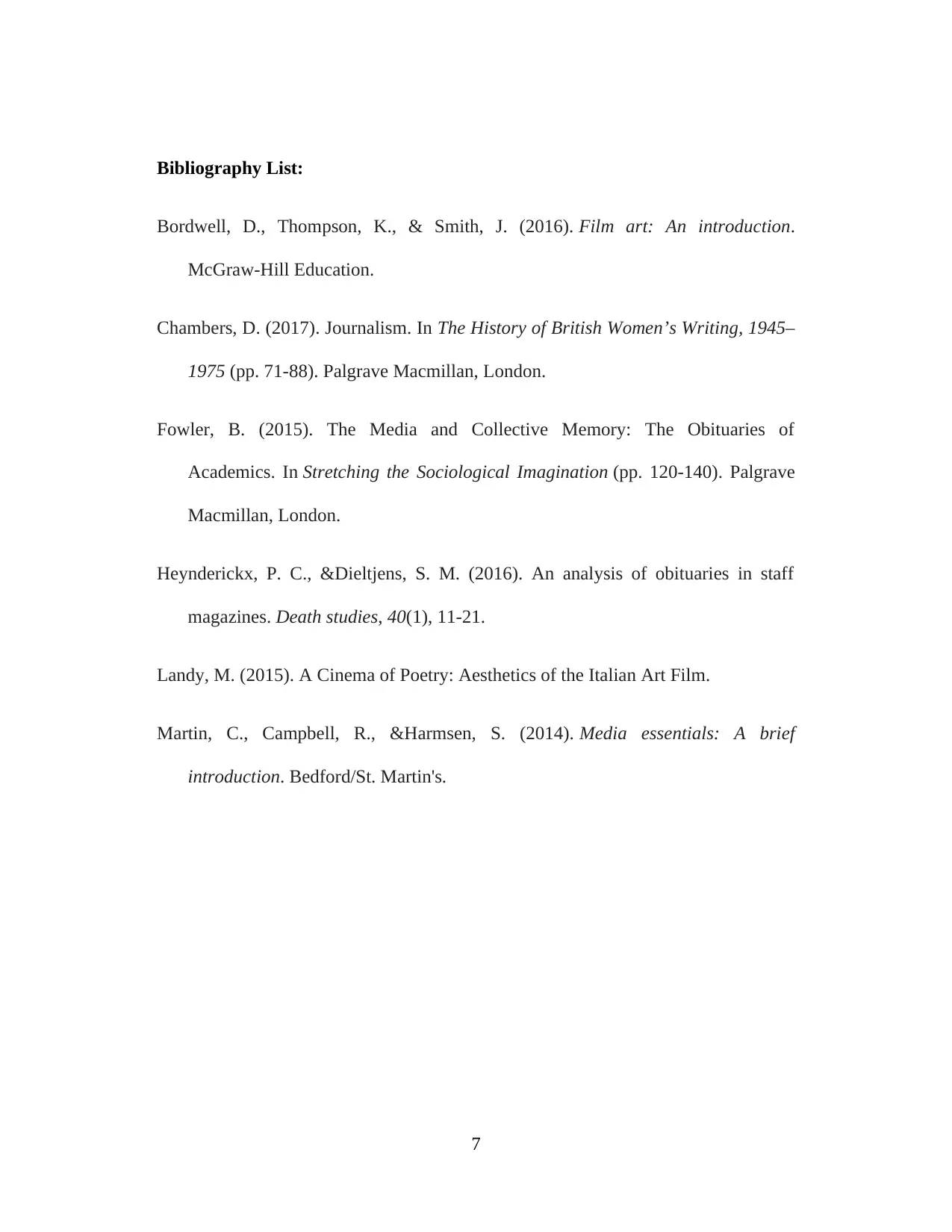
Bibliography List:
Bordwell, D., Thompson, K., & Smith, J. (2016). Film art: An introduction.
McGraw-Hill Education.
Chambers, D. (2017). Journalism. In The History of British Women’s Writing, 1945–
1975 (pp. 71-88). Palgrave Macmillan, London.
Fowler, B. (2015). The Media and Collective Memory: The Obituaries of
Academics. In Stretching the Sociological Imagination (pp. 120-140). Palgrave
Macmillan, London.
Heynderickx, P. C., &Dieltjens, S. M. (2016). An analysis of obituaries in staff
magazines. Death studies, 40(1), 11-21.
Landy, M. (2015). A Cinema of Poetry: Aesthetics of the Italian Art Film.
Martin, C., Campbell, R., &Harmsen, S. (2014). Media essentials: A brief
introduction. Bedford/St. Martin's.
7
Bordwell, D., Thompson, K., & Smith, J. (2016). Film art: An introduction.
McGraw-Hill Education.
Chambers, D. (2017). Journalism. In The History of British Women’s Writing, 1945–
1975 (pp. 71-88). Palgrave Macmillan, London.
Fowler, B. (2015). The Media and Collective Memory: The Obituaries of
Academics. In Stretching the Sociological Imagination (pp. 120-140). Palgrave
Macmillan, London.
Heynderickx, P. C., &Dieltjens, S. M. (2016). An analysis of obituaries in staff
magazines. Death studies, 40(1), 11-21.
Landy, M. (2015). A Cinema of Poetry: Aesthetics of the Italian Art Film.
Martin, C., Campbell, R., &Harmsen, S. (2014). Media essentials: A brief
introduction. Bedford/St. Martin's.
7
1 out of 8
Your All-in-One AI-Powered Toolkit for Academic Success.
+13062052269
info@desklib.com
Available 24*7 on WhatsApp / Email
![[object Object]](/_next/static/media/star-bottom.7253800d.svg)
Unlock your academic potential
Copyright © 2020–2025 A2Z Services. All Rights Reserved. Developed and managed by ZUCOL.